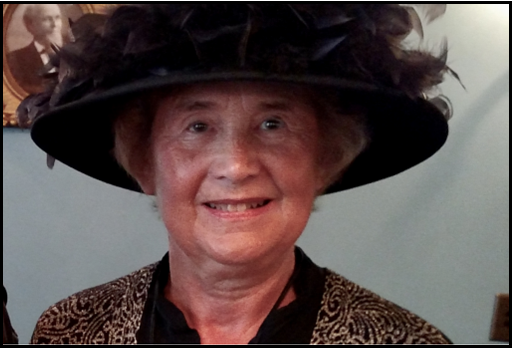Virginia Claypool Meredith (1848-1936)
 To help celebrate Purdue University’s 150th anniversary in 2019, the Purdue University Retirees Association (PURA) recruited some of its members to portray historic characters from Purdue’s past.
To help celebrate Purdue University’s 150th anniversary in 2019, the Purdue University Retirees Association (PURA) recruited some of its members to portray historic characters from Purdue’s past.
The reenactors researched their characters, developed costumes and personas, then appeared at a number of public events sharing the stories of these important Purdue figures with the public.
Joyce Beery Miles, pictured here, portrayed Virginia Claypool Meredith.
*****
Joyce is a Purdue Health and Human Sciences alumna who for the past 12 years has portrayed Ellen Swallow Richards, the founder of home economics in 1909, and the first woman to attend MIT. (A.A. Potter, former Purdue Dean of Engineering, was one of Ellen’s students at MIT in 1899.) Ellen and Virginia shared the same Progressive Era time-frame from 1870-1911, so Joyce was a natural to portray Virginia.
While Ellen was advocating for women in higher education sciences, Virginia was a struggling Eastern Indiana rancher and cattle breeder, as well as a single parent to two adoptive children.
Born in 1848, she married Henry C. Meredith in 1870. Henry died in 1882 at the age of 37, leaving Virginia a 33-year-old widow. She continued on at the Oakland farm and raised prize winning Shorthorn cattle and Southdown sheep. She had hired help on the farm, but her meticulous records on all breeding and sales made her the successful woman rancher she became. She loved answering the census every 10 years as they would ask her occupation and she would answer “farmer”.
In 1889, she became guardian to two children of a friend who had passed away, Mary L. Matthews and Meredith Matthews. She later adopted both children. Mary L. Matthews later became the first home economics graduate at the University of Minnesota and eventually, the first Dean of Home Economics at Purdue University in 1926.
Virginia was busy with community affairs and continued to travel throughout the Midwest lecturing on successful cattle breeding. She stayed on her Cambridge City farm for 46 years until the age of 67.
From 1889-1892, Virginia was a well-regarded speaker at the various Farmers Institutes throughout the state. During this time, Virginia was also selected as an Indiana representative to the Chicago World’s Fair Board of Lady Managers where her managerial skills were highly sought after. Soon after her World’s Fair duties ceased, she received another offer to go to University of Minnesota to start a Home Economics program. During this time she also participated in the Lake Placid Conferences with Ellen Richards. Eventually these conferences would become the American Home Economics Association, in 1909.
In 1921 at the age of 73, Virginia Meredith became the first woman trustee of Purdue University. She served until the time of her death in 1936, at age 87.
She was a strong supporter of women’s issues at the university and instrumental in determining the design and location of the Purdue Memorial Union, as well as its funding. Early in the process pledges had been secured providing sufficient funds to build the building, but as the economy declined, many pledges were not completed. The Purdue Trustees borrowed money twice to complete the building, which opened in 1924 when partially finished.
Meredith Hall, a women’s residence hall, was named in Virginia’s honor. Her legacy was quite far flung and women on campus today owe much to Virginia’s ability to advocate on their behalf.
Sources: Joyce Beery Miles; Fredrick Whitford, Andrew Martin, and Phyllis Mattheis, authors of the book The Queen of American Agriculture: A Biography of Virginia Claypool Meredith.
Additional information is available from the Purdue University Press and archives, including references in Angie Klink’s 2011 book Divided Paths, Common Ground: The Story of Mary Matthews and Leila Gaddis, Pioneering Purdue Women who Introduced Science into the Home. Purdue University Press. ISBN 9781557535917.
Return to PURA Historical Character Project Page
